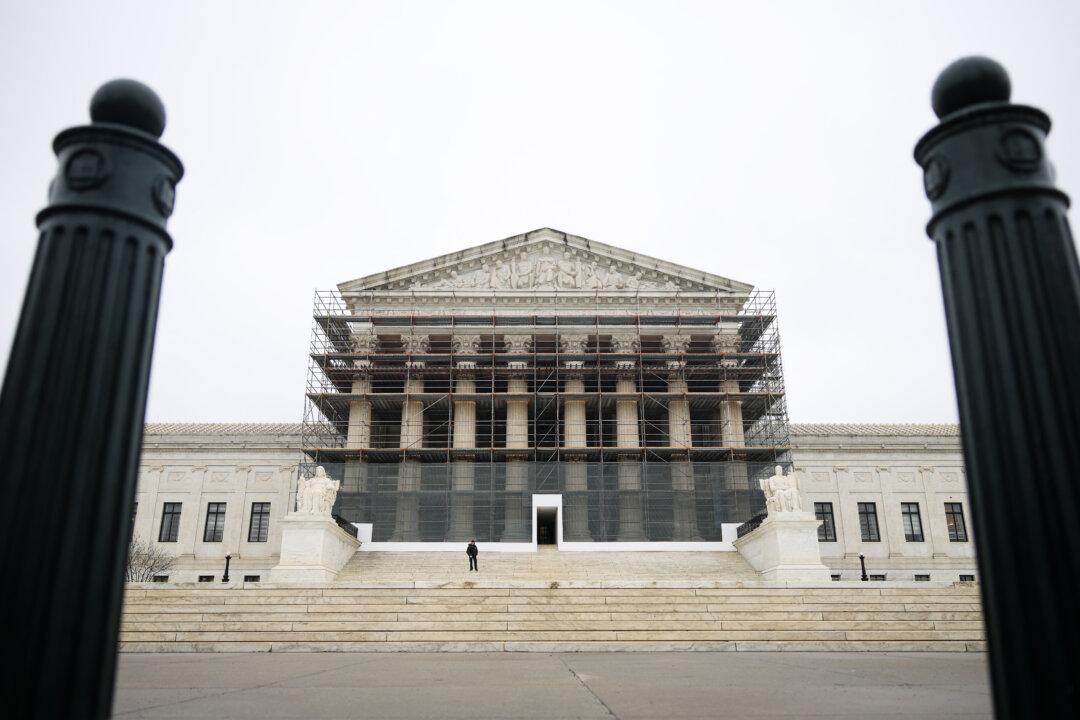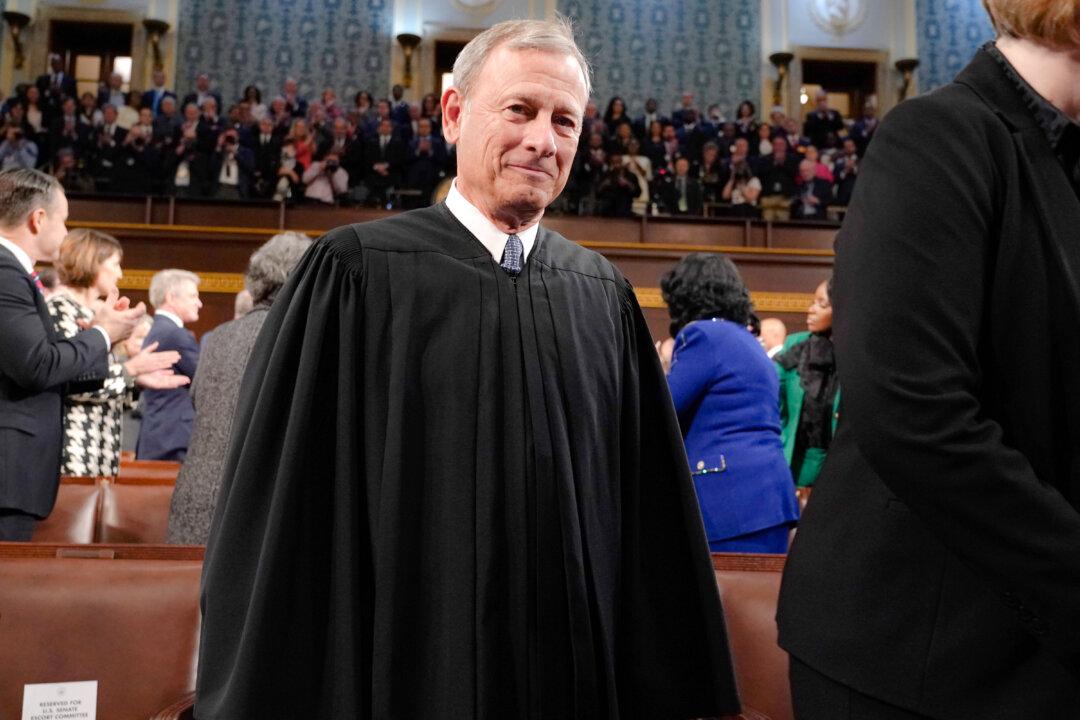President Donald Trump’s executive orders on gender in the military, along with similar orders affecting prisons, pronouns on government documents, and pediatric medicine have spawned a host of lawsuits and pushed legal questions on transgender issues to the forefront of public consciousness.
The policy questions are not new: Does a biological male have a right to use female locker rooms? Can the use of certain pronouns and identifiers be compelled? Is it right to allow hormonal treatments on minors, especially when those changes cannot be reversed?
What is new is how directly the president of the United States is tackling them.
On May 6, the Supreme Court allowed the Trump administration to ban openly transgender persons from serving in the military as litigation challenging the order plays out.
Two days later, the Department of Defense said around 1,000 such persons would “begin the voluntary separation process.”
The court battles playing out may ultimately end up at the Supreme Court. Yet, the direction the justices will take is unclear, due in part to the court’s crucial 2020 decision on sexual orientation and gender in Bostock v. Clayton County.
The Executive Orders
On his first day in office, Trump issued an order saying the government would recognize two sexes, male and female. This order directs federal agencies to eliminate “nonbinary” classifications on government documents—“X” instead of male or female—and says government-issued identification must reflect individuals’ biological sex.The order commanded government agencies to scrub websites of language promoting “gender ideology,” the belief that one’s gender may differ from one’s biological sex.
Trump’s order also directed the Federal Bureau of Prisons to house male inmates according to their biological sex, and to stop using federal money to pay for their hormone treatments.
A week later, he issued an order banning those with gender dysphoria—the belief that one is born in a body of the wrong biological sex—from military service.
The order purports to address problems related to the financial and manpower costs incurred by medical interventions to change such individuals’ sex. It also claims the presence of such troops harms cohesion and morale.
“A man’s assertion that he is a woman, and his requirement that others honor this falsehood, is not consistent with the humility and selflessness required of a service member,” the order states.
The Department of Defense later said that transgender individuals can still serve, but only in their biological sex, and if they no longer report suffering from gender dysphoria.
The next day, Jan. 28, Trump said he would defund hospitals and medical research organizations that perform gender transition procedures on youth under age 19. The order specifically asks federal agencies to ignore previous guidance by the World Professional Association for Transgender Health (WPATH), which it says “lacks scientific integrity.”
The Lawsuits
These orders—like many Trump administration policies—were met with a flood of litigation.Under the threat of losing federal dollars, many hospitals and research institutions ceased performing gender procedures on minors.
Subsequently, the activist group PFLAG (Parents and Friends of Lesbians and Gays) filed suit on behalf of six transgender youth, arguing that the young plaintiffs would suffer irreparable harm from the interruption of their gender transitions. They also argued that Trump had exceeded his executive powers by holding up funding already approved by Congress.
U.S. District Judge Brendan Hurson ruled in favor of PFLAG, writing in his opinion that interruptions to gender-altering procedures could cause “unwanted physical changes, depression, increased anxiety, heightened gender dysphoria, severe distress, [or] risk of suicide.” His March 4 order blocked the government “from conditioning, withholding, or terminating federal funding” from these institutions.
The “only two sexes” order prompted a suit by seven individuals who identified as either transgender or nonbinary. They said the new rule forces them to “out” themselves, since anyone looking at their passport may notice the gender listed does not match their appearance. This could lead to physical harm or arrest if the passport is thought to be a fake, they said.
U.S. District Judge Julia Kobick ruled in favor of the plaintiffs, whose passports will now reflect their chosen gender identity. Yet, she did not issue a nationwide block on the government’s policy.
Other suits were filed by prisoners who identified as transgender women, who said they could face sexual assault and violence if forced to live among male prisoners after their gender transition. In two of those cases, Doe v. McHenry and Jones v. Trump, federal judges blocked the inmates from being transferred to male prison facilities.
Several transgender service members have filed suit in the cases Talbott v. Trump and Shilling v. U.S., alleging that the new restrictions were misguided and based on animus toward transgender soldiers.
U.S. District Judge Ana Reyes agreed in the Talbott case. She issued a block on March 18 to prevent the plaintiffs from being separated from the military. The government has filed an appeal.
The Bostock Ultimatum
President Trump has already filed a series of appeals before the Supreme Court. It seems possible that these cases could wind up before the justices as well.If the justices do take one of the gender-related cases, they could revisit precedent such as the 2020 decision in Bostock v. Clayton County, which lower court judges have cited in their rulings against the administration.
In that case, the majority ruled that sexual orientation and gender identity are covered by Title VII of the 1964 Civil Rights Act, which prohibits workplace discrimination based on “race, color, religion, sex, [and] national origin.”
Justice Neil Gorsuch wrote in the majority opinion that “when an employer fires an employee for being homosexual or transgender, it necessarily and intentionally discriminates against that individual in part because of sex.”
Three justices—Samuel Alito, Brett Kavanaugh, and Clarence Thomas—dissented from the decision in Bostock. In his opinion, Alito criticized Gorsuch’s reasoning.
“The arrogance of this argument is breathtaking,” Alito wrote in his dissent, insisting that there “was not a shred of evidence” that Congress intended Title VII to be interpreted according to the majority’s opinion.
Some legal experts agree.
“Bostock went beyond the text and original intent of Title VII,” said John Shu, a constitutional law expert who served in both Bush administrations.
“When Congress wrote the word ‘sex’ into the 1964 statute, that word was commonly known and used to mean ‘woman’ or ‘female,’ not gay, lesbian, or transgender,” Shu added.
Equal Protection and Due Process Claims
President Trump’s orders will have to clear another hurdle: the Fifth Amendment, which has been referenced by numerous judges in blocking the president’s executive actions.In order to grasp the judges’ reasoning, it is necessary to understand that they are blending considerations from the 14th and Fifth Amendments.
Both amendments guarantee due process under the law; the 14th applies to states, and the Fifth applies to the federal government.
But the 14th Amendment also has an extra anti-discrimination clause, which guarantees equal protection under the law to U.S. citizens. The judges are applying this equal protection clause to the federal government via the Fifth Amendment.
“Even though the Fifth Amendment applies to the federal government and does not include the words ‘equal protection,’ the Supreme Court has long interpreted the Fifth Amendment’s due process clause to include an equal protection component,” former federal prosecutor Neama Rahmani told The Epoch Times.
Judges Settle and Reyes both cited the Bostock decision when ruling that President Trump’s orders violated the Fifth Amendment by separating persons from the military because they identified as transgender.
Reyes acknowledged that the Bostock ruling was restricted to workplace discrimination but said “its reasoning is not.”
“The Supreme Court deduced it impossible—end stop—to discriminate against a transgender person without discriminating against that person based on sex,” she wrote.
Former Solicitor General Elizabeth Prelogar also made that argument in U.S. v. Skrmetti, a case challenging Tennessee’s ban on gender procedures for minors. A decision in that case is expected during the Supreme Court’s current term, which will likely end this summer.
“If the Supreme Court in Skrmetti holds that state’s bans on transgender medical procedures for minors violate the Equal Protection Clause of the 14th Amendment, that same reasoning should apply to Trump’s executive orders under the Fifth Amendment,” Rahmani said.
It’s unclear how the Supreme Court will rule in U.S. v. Skrmetti, but oral argument seemed to indicate the justices were skeptical of the ban on gender procedures for minors.
Carrie Severino, a former Thomas clerk and president of JCN, told The Epoch Times that the court’s ruling “may not touch on Bostock at all in its decision in Skrmetti.”
“As Justice Alito pointed out in oral arguments, Bostock was a case that turned on specific language in Title VII that is neither in the Constitution nor at issue in this case,” she said.
“On the other hand, the dissenters may well bring it up because they’re hoping to bootstrap Bostock’s misinterpretation of Title VII into a constitutional holding,” she added.
Since the late Justice Ruth Bader Ginsburg has been replaced by Amy Coney-Barrett, it is possible that the Bostock precedent may be overturned entirely.








